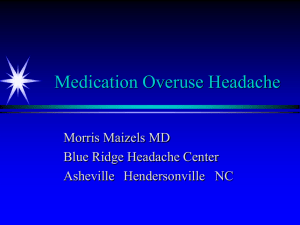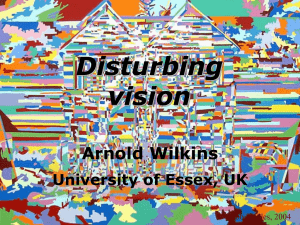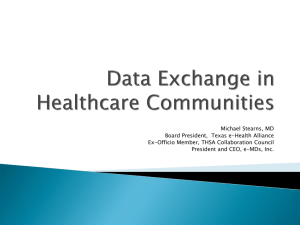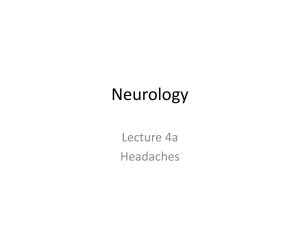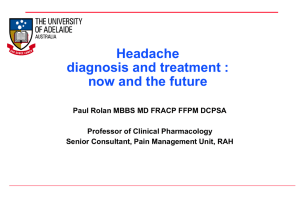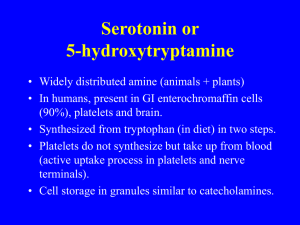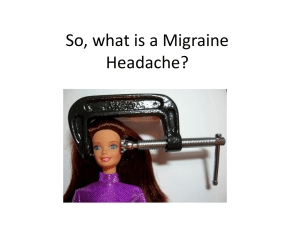MIGRAINE
advertisement
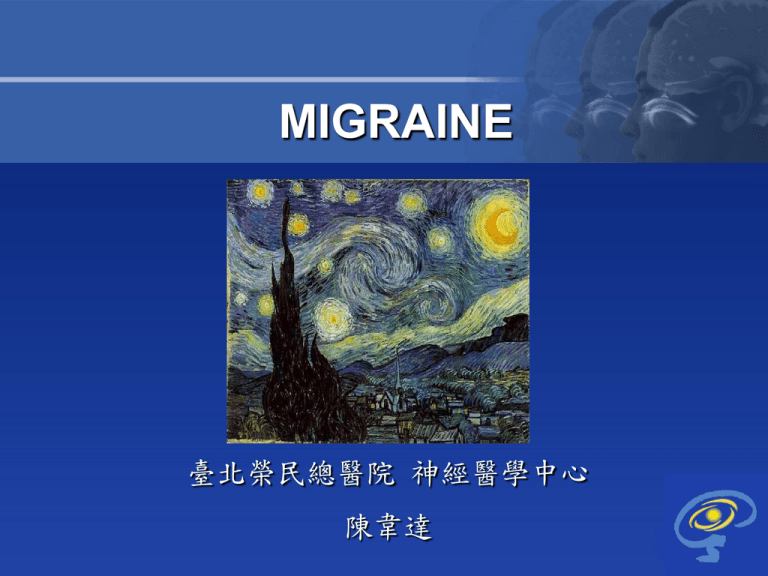
MIGRAINE 臺北榮民總醫院 神經醫學中心 陳韋達 Outline Clinical diagnosis and evaluation of migraine Pathophysiology Treatment of migraine of migraine Origin of Headache Distention, traction, or dilatation of intracranail or extracranial arteries Traction or displacement of large intracranial veins or their dural envelope Compression, traction, or inflammation of cranial and spinal nerves Spasm, inflammation, and trauma to cranial and cervical muscles Meningeal irritation and raised intracranial pressure Perturbation of intracerebral serotonergic projections impaired central inhibition? Diagnosis of Headache Disorders International Classification of Headache Disorders (ICHD) – Conducted by the Headache Classification Subcommittee of International Headache Society (IHS) – ICHD-1, 1988 (中譯版:臺大 洪祖培等) – ICHD-2, 2004 (中譯版:臺灣神經學會頭痛學組) 國際頭痛疾病分類 ICHD-2 2003/9 1、偏頭痛 2、緊縮型頭痛 3、叢發性頭痛與其他三叉自律神經頭痛 4、其他原發性頭痛 5、歸因於頭部及頸部外傷之頭痛 6、歸因於顱部或頸部血管疾患之頭痛 7、歸因於非血管性顱內疾患之頭痛 8、歸因於與物質或物質戒斷之頭痛 9、歸因於感染之頭痛 10、歸因於與体內恒定疾患之頭痛 11、歸因於頭顱、頸、眼、耳、鼻、鼻竇、牙、口或其他面部或顱部結構疾 患之頭痛或顏面痛 12、歸因於精神疾患之頭痛 13、顱神經痛和中樞性顏面痛 14、其他頭痛、顱部神經痛、中樞或原發性顏面痛 有多少人頭痛 96% 以上的人畢生會發生一次以上頭痛 1997-1999 大臺北地區頭痛調查 (15歲以上) 女性:14% 男性:5% 偏頭痛,57% 其他頭痛,29% 無 偏頭痛,46% 其他頭痛,50% 無 全臺灣15歲以上成人約 9.7 % (150萬) 的人有偏頭痛 ( 女115萬,男35萬,約3:1) 約4% (60萬) 的人其頭痛平均天數每個月超過15天,符合 慢性每日頭痛的診斷。其中三成濫用止痛藥。 Adjusted Age-specific Prevalence of Migraine Women Men 偏頭痛發作 前趨症狀 (premonitory symptoms) 疲倦、注意力差、頸部僵硬、想吃東西、呵欠 預兆 (aura) 視覺預兆: 閃光、星星、盲點、愛麗絲仙境 感覺異常: 手指末端有針刺感 運動障礙:半側偏癱 語言障礙:失語症口齒不清 頭痛發作 (headache) 發作結束 (postdrome) 診斷標準 無預兆偏頭痛 (migraine without aura) A. 至少有五次以上頭痛發作符合 B, C 和 D 項 B. 頭痛過程持續 4-72小時[沒治療或治療沒成功] C. 至少有以下四項中的兩項 一側的頭痛 搏動性的頭痛 頭痛中度到嚴重[會影響工作生活] 日常活動如走路或爬樓梯等會使頭痛加劇 D. 至少有以下兩項中的一項 噁心或嘔吐 畏光及怕吵 E. 非歸因於其他疾患 診斷標準 預兆偏頭痛 (Migraine with aura) A. 至少有兩次以上頭痛發作符合 B 項 B. 預兆至少包括下列一項 – 完全可逆視覺症狀 – 完全可逆感覺症狀 – 完全可逆失語性語言障礙 C. 至少具下列兩項 – 同名側的視覺症狀及/或單側感覺症狀 – 至少一種預兆在≥5分鐘逐漸產生,及/或不同預兆在 ≥5分鐘相繼發生 – 每一種狀持續 ≥5分鐘及 ≤60分鐘 D. 符合無預兆偏頭痛基準 B-D 的頭痛,在預兆同時或預 兆之後的60分鐘內發生 E. 非歸因於其他疾患 偏頭痛的診斷工具 頭痛日誌 記錄重點 1、疼痛程度 2、疼痛時段 3、相關症狀及預兆 4、持續時間 5、服用葯物及其有效程度 6、月經日期 頭痛疾患的診斷工具 頭痛日誌 – 頭痛位置、性質、伴隨症狀、時間與頻率因素、預兆、 誘發原因、月經日期 神經放射線檢查 – Frishberg BM 1994: CT or MRI for migraineurs with normal NE shows positive findings in 4/987(0.4%) : 3 with tumor, 1 with AVM 實驗室檢查 – 腦血管攝影、腰椎穿刺、腦波、腦血管超音波、眼底及 眼壓檢查、耳鼻喉科檢查 Diagnostic flow chart of headache Headache? thunderclap headache hyper-acute onset intracranial HTN Posture-related One-sided pain+ cranial autonomic s/s Associated w/ recent event medication overuse Trigeminal-autonomic cephalalgia Secondary headache Medication-overuse headache Migraine or other primary headaches 偏頭痛的後遺症 慢性偏頭痛 (chronic migraine) 偏頭痛重積狀態 (status Migrainosus) – 定義:偏頭痛發作時間超過三天,無頭痛時間 少於4小時 (不含睡眠) 無梗塞之持續性預兆 (persistent aura without infarction) 偏頭痛梗塞 (migrainous Infarction) – 預兆持續一小時以上併影像學之腦梗塞証據 偏頭痛引發之癲癇發作 (migraine-triggered seizure) 偏頭痛的後遺症 Deep White Matter Lesions Kruit MC, et al. JAMA 2004; 291: 427-34 Risk Factors for Chronic Daily Headache (CDH) A history of migraine Medication overuse Caffeine consumption - Dietary and medications Obesity(OR=5.3) Snoring(OR=3.3) Stressful Life Events Wang SJ. et al. Neurology 2000;54:31 4-9 Scher AJ et al. Neurology 2002;58(S3):A332 Scher AJ et al. Neurology Pain 2003;106:81-9 Lu SR et al.Cephalalgia 2001;21:980-6 Juang KD,et al. Cephalalgia 2004;24:54-9 Katsarava Z et al. Neurology 2004;62:788-90 Migraine Comorbid and Co-occurring Disorders Cardiovascular Psychiatric Hypertension Mitral valve prolapse Patent foramen ovale Raynaud’s phenomenon Stroke Depression Anxiety Bipolar disorder Eating disorders .Anorexia / bulimia .Obesity Neurologic Gastrointestinal Pulmonary Seizure disorder Gastric ulcers Irritable bowel syndrome Smoking Asthma Allergies Endocrine Chronic pain Menstrual abnormalities Hypothyroidism Fibromyalgia Chronic fatigue syndrome Migraine with aura is associated with cerebrovascular disease Myocardial infarction (MI) (OR 2.08) Coronary revascularisation (1.74) Angina (1.71) Death from ischemic cardiovascular disease (2.33) Patent foramen ovale (PFO) Other associated CV risks – Unfavourable cholesterol profile – High blood pressure – Parental history of early MI Kurth T, 2008; kurth T, 2007; Scher AI 2005 Outline Clinical diagnosis and evaluation of migraine Pathophysiology Treatment of migraine of migraine “The concept of migraine is a state of central neuronal hyperexcitability.” Welch KMA 1990 Hypersensitivity to external stimuli in Migraine Sensitivity to light, sound, and odors – Interictal – ictal Attacks triggered by light or other sensory stimuli Visual discomfort and intense illusion to grating patterns Deficient habituation in migraine Check size=8 min, reversal rate =3.1 hz Schoenen J et al, Eur J Neurol 1995;2:115-122 Deficient habituation in migraine Check size=8 min, reversal rate =3.1 hz Afra J et al., Brain 1998; 121:233-241 Serotonin may be involved in presynaptic depression Principles of Neural Science, 4/e Habituation Depends on Subcortical-cortical Aminergic Projections Sensory cortex Thalamocortical loops Thalamus Ach DA NE 5-HT Brain stem His Basal Basal forebrain forebrain State-setting State-setting chemically chemicallyaddressed addressed connections connections Repeated Stimuli Cephalalgia 2007; 27:1429-1439 Migraine: a neurochemical disorder with low serotonergic disposition Interictal – Plasma 5HT↓; HIAA↑ Ictal – Urine 5-HIAA↑ – Plasma 5HT↑; HIAA↓ Int Arch Allergy Appl Immunol 1961;19:55-8 Cephalalgia 2007;27:1296-1300 Ictal Serotonin Change in Migraine Acute headache Sumatriptan Neurology 2008;70:431-9 Interictal Fluoxetine reverses VEP dishabituation in migraine Headache 2002;42:582-7 Fluoxetine 20mg/d x 1 mo -9.3% -10.1% Headache 2002;42:582-7 Homeostatic Changes and Altered Excitability in Migraine Dysfunction Disordered Deficiency Abnormal of aminergic subcortical projections mitochondrial energy metabolism of systemic and brain Mg++ glutamate metabolism Proposed Mechanisms of Migraine Abnormal cortical Activity: Hyperexcitable brain (5HT↓, Ca ↑, Glu ↑, Mg ↓) Abnormal brainstem Function: Excitation of brain stem, PAG, etc Cortical Spreading Depression ? Activation/Sensitization of TGVS Vasodilation; Neurogenic Inflammation Central Sensitization TGVS=tngemunal vascular sensitization.Adopted from Pietrobon D. Striessing J. Nat Neurosci.2003;4:386-398. Headache Pain Cortical Spreading Depression (CSD) Leão AAP, 1914-1993 J Neurophysiol 1944;7:359-390 Cortical Spreading Depression Leão (1944): Olesen (1990): Lashley (1941): Cortical Spreading Spreading Oligemia Spreading aura Depression (CSD) 2 – 3 mm / min Milner PM (1958) 偏頭痛的腦部血流變化-- Spreading Oligemia Olesen J et al. Ann Neurol. 1990. Migraine is primarily of neural, not vascular origin. Cortical Spreading Depression in human brain PNAS 2001 (April); 98: 4687-4692 Ann Neurol 2001;50:582-587 Proposed Mechanisms of Migraine Abnormal cortical Activity: Hyperexcitable brain (5HT↓, Ca ↑, Glu ↑, Mg ↓) Abnormal brainstem Function: Excitation of brain stem, PAG, etc Cortical Spreading Depression ? Activation/Sensitization of TGVS Vasodilation Neurogenic Inflammation peripheral sensitization Central Sensitization TGVS=tngemunal vascular sensitization.Adopted from Pietrobon D. Striessing J. Nat Neurosci.2003;4:386-398. Headache Pain Trigeminal Vascular Activation NEJM 2002;346:257-270 Proposed Model of Migraine Genetic Dysfunctioned aminergic Channelopathy or transmission (5HT etc.) Ca ↑, Glu ↑, Mg ↓ & cortical hyperexcitability ↑5HT transmission Reduced mitochondrial energy reserve Excessive metabolic strain Genetic abnormality? Migraine aura Biochemical shifts Spreading depression Endogenous Pain Control system Modified from Biomed & Pharmacother 1996;50:71-78 Trigeminal Vascular activation Migraine attack 偏頭痛與遺傳 偏頭痛患者有70%以上亦有家屬罹病 父母有一人偏頭痛,則小孩罹病率 46% 父母雙方均偏頭痛,則小孩罹病率 66% 預兆型偏頭痛比無預兆型更易遺傳 一般常見之偏頭痛則為多重基因遺傳 能表現遺傳性偏頭痛之特定基因病變 – FHM-1, FHM-2, FHM-3 家族性偏癱性偏頭痛 (Familial hemiplegic migraine, FHM) – – NOTCH 3 gene CADASIL (cerebral autosomal dominant arteriopathy with subcortical infarcts and leukoencephalopathy) SLC1A3 EAAT1 (excitatory amino acid transporter 1) glutamate transporter Vande Ven RCG. Arch Neurol 2007 Familial Hemiplegic Migraine Animal Models of Migraine in the past three decades Outline Clinical diagnosis and evaluation of migraine Pathophysiology Treatment of migraine of migraine 偏頭痛急性治療 Triptans (翠普登) – Sumatriptan 50mg po – Sumatriptan 20mg in – Sumatriptan 50mg, 100mg FDT (fast-disintegrating tablet) Ergots (麥角胺) – Ergotamine 1mg/caffeine 100mg (eg. Cafergot etc.) 2# po – Dihydroergotamine 5-10 mg po NSAIDs: ketorolac 2 mg im/iv, oral NSAIDs Others – Neuroleptics: prochlorperazine 5-10 mg iv – Corticosteroids: dexamethasone 5 mg im 偏頭痛急性治療準則 儘早用藥,效果確實 分層治療 – 輕中度偏頭痛:以非類固醇抗發炎藥物為第一線 – 中重度偏頭痛:以翠普登或麥角胺為第一線 藥物併用,療效更佳,如翠普登併用NSAID,或多巴胺拮 抗劑併用其他急性用藥 特殊情形 – 孕婦或兒童,以單純止痛藥乙醯氨酚為第一線 – 偏頭痛重積狀態,優先使用類固醇 頻繁使用急性治療,可能導致「藥物過度使用頭痛」 Medication Overuse Headache, MOH Triptans 翠普登 Agonists for 5-HT 1B/1D ± 5-HT 1F 1st triptan: sumatriptan 2nd triptan: zolmi-, nara-, *riza-, *almo-, frova-, *ele– Higher central penetrance – *Highest 2h effectiveness with relief within 30-60 min Imigran® 英明格 (1 tab = sumatriptan 50 mg) – – Onset ~ 40-60 min Abolish pain ~ 2-4 hr – Responder rate ~ 70% – Also effective for nausea, vomiting photophobia and phonophobia Ergotamine Non-selective Agonists for 5-HT 1B/1D ± 5-HT 1F ergotamine 1mg/caffeine 100mg Dihydroergotamine 5mg 加非葛Cafergot 治偏頭痛錠Antimigraine 克痛敏Cafegotamine 可伏痛Cafeton 痛安錠Ergocafe 易克痛Ergoton 麥角咖啡鹼錠Coffegot 豐醫痛錠Ergoffeine 益汝朗Ergodan 偏痛停Migratin 倍安達Baenta 優去痛敏Yuchitonmin 痛平定Tonpen 益可達Ergolar 益克偏Ergofen 麥咖因 Ergocaine 塞戈羅Seglor (5mg;其中 1.5mg為立即釋放劑型、3.5mg 為緩慢釋放劑型) 道得通Dihydergot (2.5mg) 樂又適Rayosu (1mg) 安得寧Antoxine (1.5mg) Triptans/Ergots for Migraine Treatment NEJM 2002;346:257-270 Key Differences Ergots vs. Triptans Ergots Triptans 5-HT 1A ++++ + 1B 1D +++ +++ ++ +++ 2A 2C +++ +++ – – Adrenergic a1 a2 +++ +++ – – Dopamine D2 +++ – Dysphoria Nausea / Emesis Anti-migraine Peripheral Vascular Effects Asthenia Dizziness GI / Nausea / Emesis Triptan/Ergot Contraindication and Adverse Events Contraindication – ischemic heart disease – uncontrolled HTN – basilar or hemiplegic migraine – pregnancy – MAO-I use Adverse Events – paresthesia, tingling – flushing, burning, or warm/hot sensation – dizzy, somnolence, fatigue, heaviness 偏頭痛預防療法 Anti-epileptic drugs (AED) – topiramate、valproic acid、gabapentin Beta-blockers – propranolol、atenolol、nadolol、metoprolol Calcium channel blockers – flunarizine、verapamil Anti-Depressants – TCA, selective serotonin reuptake inhibitors American Association of Neurology, 2000 Mechanism of Migrane Preventatives Glutamate GABA Neurotransmission Neurotransmission NE 5-HT β-Blockers TCAs CCBs VPA GBP TPM CCBs=calcium channel blockers; VPA=valproate; GBP=gabapentin; TPM=topiramate. Adapted from Silberstein SD et al. Wolff’s Headache and Other Head Pain. 2001:121-237. 偏頭痛預防療法 採行時機 每個月頭痛3-4次以上或慢性頭痛 急性藥物無法完全減輕頭痛,或有使用禁忌者 急性藥物每週使用超過兩次以上 發作時間超過48小時或發作程度過於嚴重影響生活品質 特殊形式偏頭痛,如併偏癱、過長預兆,或偏頭痛腦梗塞 施行方式 每天服藥,一般需持續4-6個月,並於2-3週逐漸減藥 預期效果 頭痛發生率降低50+%;急診求診頻次降低 82% 減少不必要之腦部造影檢查CT 75%,MRI 88% TAKE HOME MESSAGES Migraine is a prevalent, disabling neurological disease more common in female and associated with cardiovascular risks Hyperexcitability of brain is the pivotal pathomechanism of migraine, which may be linked to inherited channelopathy, dysfunctioned amine transmission, and reduced mitochondrial energy reserve Triptans and ergots are migraine-specific acute treatments, acting by 5HT1b/1d antagonism Anticonvulsants can prevent migraine probably due to the effect of neuro-stabilization after long-term use
